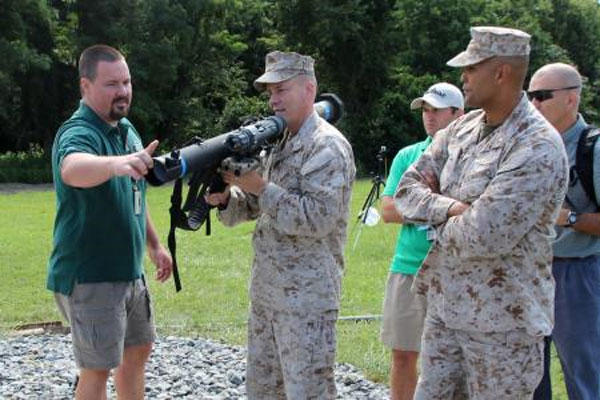DAHLGREN, Va. - Marine Corps Systems Command and the Naval Surface Warfare Center Dahlgren Division are teaming to upgrade one of the longest-serving and most trusted Marine Corps weapons with improvements that would increase readiness levels and make it easier to employ.
The shoulder-launched multipurpose assault weapon, or SMAW, was first fielded in 1984. The SMAW that is in the field today, the MK153 Mod 0, bears the same design from nearly 30 years ago. The new version, the MK153 Mod 2, was developed by NSWCDD and is currently undergoing developmental testing at NSWCDD in Dahlgren, Va.
The launcher and its family of rockets comprise a weapon system that gives an assault team the ability to defeat bunkers, other fortified positions, light armored vehicles and other targets at ranges between 50 and 500 meters.
The problem with the SMAW Mod 0 is not the launcher itself.
“It’s a very reliable, very robust weapon system,” said Ryan Smith, MCSC’s SMAW project officer. “The main focus is improving the SMAW and there are a lot of things that go into that.”
The primary modification on the SMAW Mod 2 is a new aiming system that is more reliable and easier to maintain over the existing targeting and ranging system.
The Mod 0’s current primary aiming system, a spotting rifle, shoots 9mm tracer bullets that are a close ballistic match for the SMAW’s rockets. To aim the SMAW Mod 0, users take aim at their targets with the rifle and fire. When the Marine hits the target with the 9mm bullet, the gunner can then fire the rocket.
This antiquated aiming system presents a number of problems.
“The spotting rifle is the most maintenance intensive component of the weapon,” said Daniel Ross, an engineer working on the SMAW project. “The aiming process is trial and error … it’s obsolete.”
The spotting rifle reduces the availability of the entire weapon to Marines, Ross said. It also causes Marines to expose themselves to enemy fire for long periods and alerts their targets to their location with the sound of gunfire while they aim. The spotting rifle also adds several pounds to the SMAW.
The new aiming system, the modular ballistic sight, or MBS, is lightweight, reliable and detachable. It features a laser range finder and thermal weapon sight that will provide the user a firing solution using a displaced reticle—crosshairs adjusted for distance and environmental factors.
“Move the reticle onto the target and that’s your firing solution,” Ross added. “It drastically reduces the time Marines are out in the open.”
MCSC, the Department of the Navy's systems command for Marine Corps ground weapon and information technology systems and the Marine Corps commandant's agent for acquisition and sustainment of warfighting systems and equipment, is making changes to the SMAW based on the Follow-On To SMAW, or FOTS, requirements.
“Some would like to see the SMAW go away because it’s old,” Smith said. “There are so many little hidden gems about the SMAW Mod 2 that will make it more user friendly, lighter in weight, easier to maintain and more available to the Marine.”
Those hidden gems include allowing the MBS to detach from the launcher, increased pad size on the forward grip and foldable backup sights on the launcher to replace the rigid iron sights.
“The Mod 0 weighs 16.5 pounds,” Smith said. “The SMAW Mod 2 launcher with the MBS attached weighs approximately 13 pounds (8.5 pounds with the MBS detached). The old backup iron sights used to get bent if the launcher was mishandled, so that was another common failure. And increasing the pad size on the front grip is something we can do to keep it from breaking off.”
Smith hopes to convince Marines that keeping the same basic design on the trusty SMAW was the right move.
“It’s the little things,” he said. “We’re trying to make the point to Marines that we’re doing good things.”




























